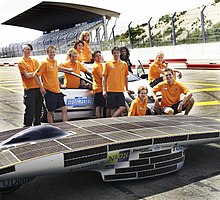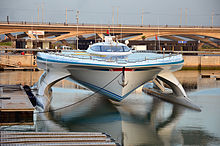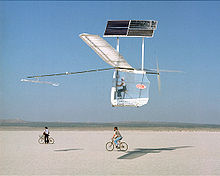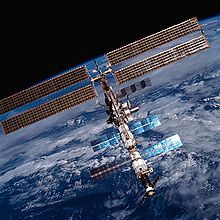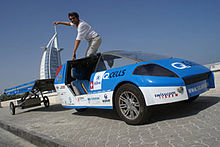U.S.
Secretary of State John Kerry admires a solar-powered car built by
members of the Tomodachi Initiative youth engagement program in Tokyo,
Japan, on April 14, 2013.
A solar vehicle is an electric vehicle powered completely or significantly by direct solar energy. Usually, photovoltaic (PV) cells contained in solar panels convert the sun's energy directly into electric energy. The term "solar vehicle" usually implies that solar energy is used to power all or part of a vehicle's propulsion. Solar power may be also used to provide power for communications or controls or other auxiliary functions.
Solar vehicles are not sold as practical day-to-day
transportation devices at present, but are primarily demonstration
vehicles and engineering exercises, often sponsored by government
agencies. However, indirectly solar-charged vehicles are widespread and solar boats are available commercially.
Land
Solar cars
Solar cars depend on PV cells to convert sunlight into electricity to
drive electric motors. Unlike solar thermal energy which converts solar
energy to heat, PV cells directly convert sunlight into electricity.
The design of a solar car is severely limited by the amount of energy input into the car. Solar cars are built for solar car races and also for public use.
Even the best solar cells can only collect limited power and energy
over the area of a car's surface. This limits solar cars to ultralight
composite bodies to save weight. Solar cars lack the safety and
convenience features of conventional vehicles. The first solar family
car was built in 2013 by students in the Netherlands.
This vehicle is capable of 550 miles on one charge during sunlight. It
weighs 850 pounds and has a 1.5kw solar array. Solar vehicles must be
light and efficient. 3,000 pound or even 2,000 pound vehicles are less
practical. Stella Lux,
the predecessor to Stella, broke a record with a 932 mile single charge
range. The Dutch are trying to commercialize this technology. During
racing Stella Lux is capable of 700 miles during daylight. At 45 mph
Stella Lux has infinite range. This is again due to high efficiency
including a Coefficient of drag
of .16. The average family who never drive more than 200 miles a day
would never need to charge from the mains. They would only plug in if
they wanted to return energy to the grid.
Solar cars are often fitted with gauges and/or wireless telemetry,
to carefully monitor the car's energy consumption, solar energy capture
and other parameters. Wireless telemetry is typically preferred as it
frees the driver to concentrate on driving, which can be dangerous in
such a small, lightweight car. The Solar Electric Vehicle system was
designed and engineered as an easy to install (2 to 3 hours) integrated
accessory system with a custom molded low profile solar module,
supplemental battery pack and a proven charge controlling system.
As an alternative, a battery-powered electric vehicle may use a
solar array to recharge; the array may be connected to the general
electrical distribution grid.
Solar buses
Solar buses are propulsed by solar energy, all or part of which is collected from stationary solar panel installations. The Tindo bus is a 100% solar bus that operates as free public transport service in Adelaide City as an initiative of the City Council. Bus services which use electric buses
that are partially powered by solar panels installed on the bus roof,
intended to reduce energy consumption and to prolong the life cycle of
the rechargable battery of the electric bus, have been put in place in
China.
Solar buses are to be distinguished from conventional buses in
which electric functions of the bus such as lighting, heating or
air-conditioning, but not the propulsion itself, are fed by solar
energy. Such systems are more widespread as they allow bus companies to
meet specific regulations, for example the anti-idling
laws that are in force in several of the US states, and can be
retrofitted to existing vehicle batteries without changing the
conventional engine.
Single-track vehicles
The first solar "cars" were actually tricycles or Quadracycles built with bicycle technology. These were called solarmobiles at the first solar race, the Tour de Sol
in Switzerland in 1985. With 72 participants, half used solar power
exclusively while the other half used solar-human-powered hybrids. A few
true solar bicycles were built, either with a large solar roof, a small
rear panel, or a trailer with a solar panel. Later more practical solar
bicycles were built with foldable panels to be set up only during
parking. Even later the panels were left at home, feeding into the
electric mains, and the bicycles charged from the mains. Today highly
developed electric bicycles
are available and these use so little power that it costs little to buy
the equivalent amount of solar electricity. The "solar" has evolved
from actual hardware to an indirect accounting system. The same system
also works for electric motorcycles, which were also first developed for
the Tour de Sol.
Applications
The
Venturi Astrolab in 2006 was the world's first commercial electro-solar
hybrid car, and was originally due to be released in January 2008.
In May 2007 a partnership of Canadian companies led by Hymotion altered a Toyota Prius
to use solar cells to generate up to 240 watts of electrical power in
full sunshine. This is reported as permitting up to 15 km extra range on
a sunny summer day while using only the electric motors.
An inventor from Michigan, USA built a street legal, licensed,
insured, solar charged electric scooter in 2005. It had a top speed
controlled at a bit over 30 mph, and used fold-out solar panels to
charge the batteries while parked.
Nuna 3 PV powered car
Auxiliary power
Photovoltaic modules are used commercially as auxiliary power units on passenger cars
in order to ventilate the car, reducing the temperature of the
passenger compartment while it is parked in the sun. Vehicles such as
the 2010 Prius, Aptera 2, Audi A8, and Mazda 929 have had solar sunroof options for ventilation purposes.
The area of photovoltaic modules required to power a car with
conventional design is too large to be carried on board. A prototype car
and trailer has been built Solar Taxi. According to the website, it is capable of 100 km/day using 6m2 of standard crystalline silicon cells. Electricity is stored using a nickel/salt battery. A stationary system such as a rooftop solar panel, however, can be used to charge conventional electric vehicles.
It is also possible to use solar panels to extend the range of a hybrid or electric car, as incorporated in the Fisker Karma, available as an option on the Chevy Volt, on the hood and roof of "Destiny 2000" modifications of Pontiac Fieros, Italdesign Quaranta, Free Drive EV Solar Bug,
and numerous other electric vehicles, both concept and production. In
May 2007 a partnership of Canadian companies led by Hymotion added PV
cells to a Toyota Prius to extend the range. SEV claims 20 miles per day from their combined 215W module mounted on the car roof and an additional 3kWh battery.
On 9 June 2008, the German and French Presidents announced a plan to offer a credit of 6-8g/km of CO2
emissions for cars fitted with technologies "not yet taken into
consideration during the standard measuring cycle of the emissions of a
car". This has given rise to speculation that photovoltaic panels might be widely adopted on autos in the near future.
It is also technically possible to use photovoltaic technology, (specifically thermophotovoltaic
(TPV) technology) to provide motive power for a car. Fuel is used to
heat an emitter. The infrared radiation generated is converted to
electricity by a low band gap PV cell (e.g. GaSb). A prototype TPV
hybrid car was even built. The "Viking 29"
was the World’s first thermophotovoltaic (TPV) powered automobile,
designed and built by the Vehicle Research Institute (VRI) at Western
Washington University. Efficiency would need to be increased and cost
decreased to make TPV competitive with fuel cells or internal combustion
engines.
Personal rapid transit
JPods PRT concept with photovoltaic panels above guideways
Several personal rapid transit (PRT) concepts incorporate photovoltaic panels.
Rail
Railway presents a low rolling resistance option that would be beneficial of planned journeys and stops. PV panels were tested as APUs on Italian rolling stock under EU project.PVTRAIN. Direct feed to a DC grids avoids losses through DC to AC conversion.
DC grids are only to be found in electric powered transport: railways,
trams and trolleybuses. Conversion of DC from PV panels to grid
alternating current (AC) was estimated to cause around 3% of the
electricity being wasted.
PVTrain concluded that the most interest for PV in rail transport
was on freight cars where on board electrical power would allow new
functionality:
- GPS or other positioning devices, so as to improve its use in fleet management and efficiency.
- Electric locks, a video monitor and remote control system for cars with sliding doors, so as to reduce the risk of robbery for valuable goods.
- ABS brakes, which would raise the maximum velocity of freight cars to 160 km/h, improving productivity.
The Kismaros – Királyrét narrow-gauge line near Budapest has built a
solar powered railcar called 'Vili'. With a maximum speed of 25 km/h,
'Vili' is driven by two 7 kW motors capable of regenerative braking and
powered by 9.9m2 of PV panels. Electricity is stored in on-board
batteries.
In addition to on-board solar panels, there is the possibility to use
stationary (off-board) panels to generate electricity specifically for
use in transport.
A few pilot projects have also been built in the framework of the
"Heliotram" project, such as the tram depots in Hannover Leinhausen and Geneva (Bachet de Pesay). The 150 kWp
Geneva site injected 600V DC directly into the tram/trolleybus
electricity network provided about 1% of the electricity used by the
Geneva transport network at its opening in 1999. On December 16, 2017 a
fully solar-powered train was launched in New South Wales, Australia.
The train is powered using onboard solar panels and onboard
rechargeable batteries. It holds a capacity for 100 seated passenger for
a 3 km journey.
Recently Imperial College London and the environmental charity 10:10 have announced the Renewable Traction Power project to investigate using track-side solar panels to power trains. Meanwhile, Indian railways announced their intention to use on board PV to run air conditioning systems in railway coaches.. Also, Indian Railways announced it is to conduct a trial run by the end of May 2016.
It hopes that an average of 90,800 liters of diesel per train will be
saved on an annual basis, which in turn results in reduction of 239
tones of CO2.
Water
PlanetSolar, the world's largest solar-powered boat and the first ever solar electric vehicle to circumnavigate the globe (in 2012).
Solar powered boats have mainly been limited to rivers and canals,
but in 2007 an experimental 14m catamaran, the Sun21 sailed the Atlantic
from Seville to Miami, and from there to New York. It was the first crossing of the Atlantic powered only by solar.
Japan's biggest shipping line Nippon Yusen KK and Nippon Oil Corporation said solar panels capable of generating 40 kilowatts of electricity would be placed on top of a 60,213 ton car carrier ship to be used by Toyota Motor Corporation.
In 2010, the Tûranor PlanetSolar, a 30 meter long, 15.2 metre wide catamaran yacht powered by 470 square metres of solar panels, was unveiled. It is, so far, the largest solar-powered boat ever built. In 2012, PlanetSolar became the first ever solar electric vehicle to circumnavigate the globe.
Various demonstration systems have been made. Curiously, none yet
takes advantage of the huge power gain that water cooling would bring.
The low power density of current solar panels limits the use of
solar propelled vessels, however boats that use sails (which do not
generate electricity unlike combustion engines) rely on battery power
for electrical appliances (such as refrigeration, lighting and
communications). Here solar panels have become popular for recharging
batteries as they do not create noise, require fuel and often can be
seamlessly added to existing deck space.
Air
The Swiss solar-powered aircraft Solar Impulse completed a circumnavigation of the world in 2016.
Gossamer Penguin
Solar ships can refer to solar powered airships or hybrid airships.
There is considerable military interest in unmanned aerial vehicles
(UAVs); solar power would enable these to stay aloft for months,
becoming a much cheaper means of doing some tasks done today by
satellites. In September 2007, the first successful flight for 48h under
constant power of a UAV was reported.
This is likely to be the first commercial use for photovoltaics in flight.
Many demonstration solar aircraft have been built, some of the best known by AeroVironment.
Manned solar aircraft
- Gossamer Penguin,
- Solar Challenger - This aircraft flew 163 miles (262 km) from Paris, France to England on solar power.
- Sunseeker
- Solar Impulse – two single-seat aircraft, the second of which circumnavigated the Earth. The first aircraft completed a 26-hour test flight in Switzerland on 8-9 July 2010. The aircraft was flown to a height of nearly 28,000 feet (8,500 meters) by Andre Borschberg. It flew overnight using battery power. The second aircraft, slightly larger and more powerful, took off from Abu Dhabi in 2015, flew towards India and then eastward across Asia. However, after experiencing battery overheating, it was forced to halt in Hawaii over the winter. In April 2016, it resumed its journey, and completed its circumnavigation of the globe, returning to Abu Dhabi on 26 July 2016.
- SolarStratos – Swiss stratospheric 2-seater solar plane aims to climb into space.
Hybrid airships
An
Australian-based company is working on a project to develop an air
crane called the SkyLifter, a "vertical pick-up and delivery aircraft"
being capable of lifting up to 150 tons.
A Canadian start-up, Solar Ship
Inc, is developing solar powered hybrid airships that can run on solar
power alone. The idea is to create a viable platform that can travel
anywhere in the world delivering cold medical supplies and other
necessitates to locations in Africa and Northern Canada without needing
any kind of fuel or infrastructure. The hope is that technology
developments in solar cells and the large surface area provided by the
hybrid airship are enough to make a practical solar powered aircraft.
Some key features of the Solarship are that it can fly on aerodynamic
lift alone without any lifting gas,
and the solar cells along with the large volume of the envelope allow
the hybrid airship to be reconfigured into a mobile shelter that can
recharge batteries and other equipment.
The Hunt GravityPlane (not to be confused with the ground-based gravity plane) is a proposed gravity-powered glider by Hunt Aviation in the USA.
It also has aerofoil wings, improving its lift-drag ratio and making
it more efficient. The GravityPlane requires a large size in order to
obtain a large enough volume-to-weight ratio to support this wing
structure, and no example has yet been built. Unlike a powered glider,
the GravityPlane does not consume power during the climbing phase of
flight. It does however consume power at the points where it changes its
buoyancy between positive and negative values. Hunt claim that this can
nevertheless improve the energy efficiency of the craft, similar to the
improved energy efficiency of underwater gliders over conventional methods of propulsion.
Hunt suggest that the low power consumption should allow the craft to
harvest sufficient energy to stay aloft indefinitely. The conventional
approach to this requirement is the use of solar panels in a solar-powered aircraft.
Hunt has proposed two alternative approaches. One is to use a wind
turbine and harvest energy from the airflow generated by the gliding
motion, the other is a thermal cycle to extract energy from the
differences in air temperature at different altitudes.
Unmanned aerial vehicles
- Pathfinder and Pathfinder-Plus - This UAV demonstrated that an airplane could stay aloft for an extended period of time fueled purely by solar power.
- Helios - Derived from the Pathfinder-Plus, this solar cell and fuel cell powered UAV set a world record for flight at 96,863 feet (29,524 m).
- Zephyr - built by Qinetiq, this UAV set the unofficial world record for longest duration unmanned flight at over 82 hours on 31 July 2008. Just 15 days after the Solar Impulse flight mentioned above, on 23 July 2010 the Zephyr, a lightweight unmanned aerial vehicle engineered by the United Kingdom defense firm QinetiQ, claimed the endurance record for an unmanned aerial vehicle. It flew in the skies of Arizona for over two weeks (336 hours). It has also soared to over 70,700 feet (21.5 km).
- China's designed and manufactured UAV successfully reached an altitude of 20,000 meters during a test flight in the country's northwest regions. Named "Caihong" (CH), or "Rainbow" in English, it was developed by a research team from CASC.
Future projects
- The Persistent High Altitude Solar Aircraft Phasa-35 being developed by BAE Systems & aerospace technology firm Prismatic for test flights in 2019.
- Titan Aerospace acquired by Google aimed to develop the Solar UAV, however the project seems to be abandoned
- Sky-Sailor (aimed at Martian flight)
- Various solar airship projects, such as Lockheed Martin's "High Altitude Airship"
Space
Solar powered spacecraft
PV on the International Space Station
Solar energy is often used to supply power for satellites and
spacecraft operating in the inner solar system since it can supply
energy for a long time without excess fuel mass. A Communications satellite
contains multiple radio transmitters which operate continually during
its life. It would be uneconomic to operate such a vehicle (which may be
on-orbit for years) from primary batteries or fuel cells, and refueling in orbit
is not practical. Solar power is not generally used to adjust the
satellite's position, however, and the useful life of a communications
satellite will be limited by the on-board station-keeping fuel supply.
Solar propelled spacecraft
A few spacecraft operating within the orbit of Mars have used solar power as an energy source for their propulsion system.
All current solar powered spacecraft use solar panels in conjunction with electric propulsion, typically ion drives as this gives a very high exhaust velocity, and reduces the propellant over that of a rocket by more than a factor of ten. Since propellant is usually the biggest mass on many spacecraft, this reduces launch costs.
Other proposals for solar spacecraft include solar thermal heating of propellant, typically hydrogen or sometimes water is proposed. An electrodynamic tether can be used to change a satellite's orientation or adjust its orbit.
Another concept for solar propulsion in space is the light sail; this doesn't require conversion of light to electrical energy, instead relying directly on the tiny but persistent radiation pressure of light.
Planetary exploration
Perhaps
the most successful solar-propelled vehicles have been the "rovers"
used to explore surfaces of the Moon and Mars. The 1977 Lunokhod program and the 1997 Mars Pathfinder
used solar power to propel remote controlled vehicles. The operating
life of these rovers far exceeded the limits of endurance that would
have been imposed, had they been operated on conventional fuels.
Electric vehicle with solar assist
A
Swiss project, called "Solartaxi", has circumnavigated the world. This
is the first time in history an electric vehicle (not self sufficient
solar vehicle) has gone around the world, covering 50000 km in 18 months
and crossing 40 countries. It is a road-worthy electric vehicle hauling
a trailer with solar panels, carrying a 6 m² sized solar array. The
Solartaxi has Zebra batteries,
which permit a range of 400 km without recharging. The car can also run
for 200 km without the trailer. Its maximum speed is 90 km/h. The car
weighs 500 kg and the trailer weighs 200 kg. According to initiator and
tour director Louis Palmer,
the car in mass production could be produced for 16000 Euro. Solartaxi
has toured the World from July 2007 till December 2008 to show that
solutions to stop global warming are available and to encourage people
in pursuing alternatives to fossil fuel. Palmer suggests the most economical location for solar panels for an electric car is on building rooftops though, likening it to putting money into a bank in one location and withdrawing it in another.
Louis Palmer standing in the Solartaxi.
Solar Electrical Vehicles is adding convex solar cells to the roof of hybrid electric vehicles.
Plug-in hybrid and solar vehicles
An interesting variant of the electric vehicle is the triple hybrid vehicle—the PHEV that has solar panels as well to assist.
The 2010 Toyota Prius model has an option to mount solar panels on the roof. They power a ventilation system while parked to help provide cooling. There are many applications of photovoltaics in transport either for motive power or as auxiliary power units,
particularly where fuel, maintenance, emissions or noise requirements
preclude internal combustion engines or fuel cells. Due to the limited
area available on each vehicle either speed or range or both are limited
when used for motive power.
PV used for auxiliary power on a yacht
Limitations
There are limits to using photovoltaic (PV) cells for vehicles:
- Power density: Power from a solar array is limited by the size of the vehicle and area that can be exposed to sunlight. This can also be overcome by adding a flatbed and connecting it to the car and this gives more area for panels for powering the car. While energy can be accumulated in batteries to lower peak demand on the array and provide operation in sunless conditions, the battery adds weight and cost to the vehicle. The power limit can be mitigated by use of conventional electric cars supplied by solar (or other) power, recharging from the electrical grid.
- Cost: While sunlight is free, the creation of PV cells to capture that sunlight is expensive. Costs for solar panels are steadily declining (22% cost reduction per doubling of production volume).
- Design considerations: Even though sunlight has no lifespan, PV cells do. The lifetime of a solar module is approximately 30 years. Standard photovoltaics often come with a warranty of 90% (from nominal power) after 10 years and 80% after 25 years. Mobile applications are unlikely to require lifetimes as long as building integrated PV and solar parks. Current PV panels are mostly designed for stationary installations. However, to be successful in mobile applications, PV panels need to be designed to withstand vibrations. Also, solar panels, especially those incorporating glass, have significant weight. In order for its addition to be of value, a solar panel must provide energy equivalent to or greater than the energy consumed to propel its weight.

